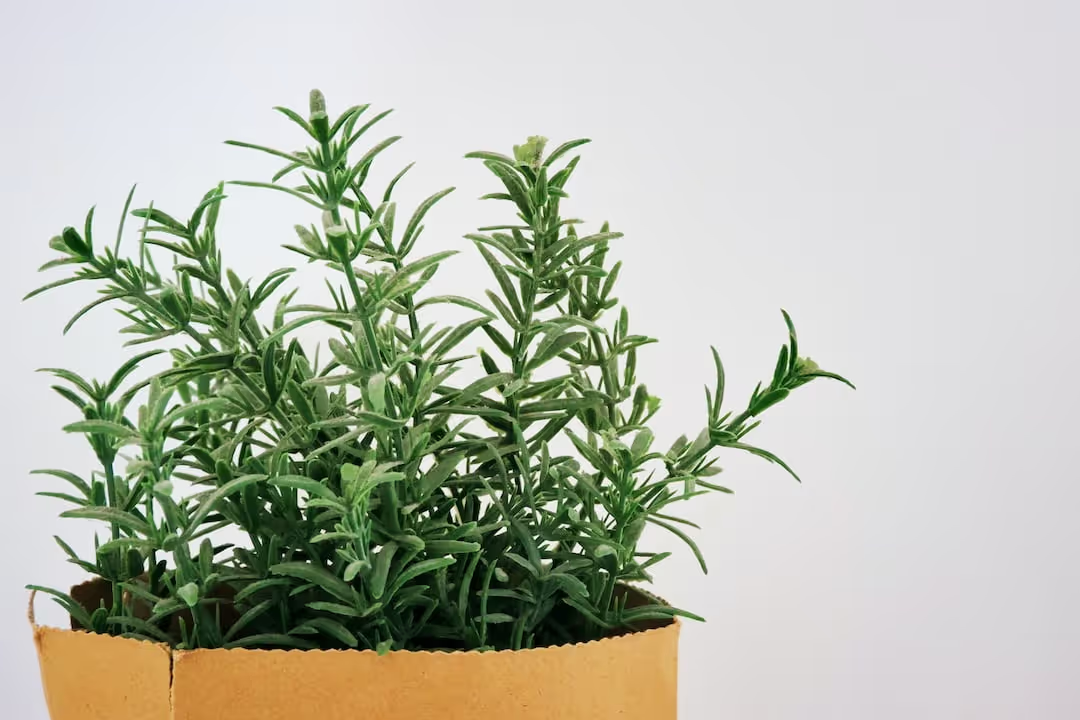Growing Rosemary: How to Plant, Care, and Harvest at Home

Growing Rosemary
Growing rosemary rewards gardeners with aromatic flavor year-round. Start by planting rosemary in full sun, using well-draining soil, and watering sparingly to prevent root rot. Master growing rosemary, and you'll enjoy fresh sprigs for cooking, fragrant foliage for bouquets, and a hardy herb thriving with minimal fuss. Here’s how to keep your rosemary lush, aromatic, and thriving season after season.
Cheatsheet: Home Rosemary Mastery
🌱 Planting
- Light: 6+ hours total sun daily
- Soil: Fast-draining, sandy, pH 6.0–7.5
- Spacing: 2–3 ft (60–90 cm) apart
- Temp: ≥ 60°F (16°C); protect below 30°F (-1°C)
- Seeds: Slow to germinate—opt for cuttings if possible
- Transplant: After last frost
🧰 Tools and Products You'll Need
- Pot or garden bed with drainage
- Pruners or sharp scissors
- Organic potting mix or sandy loam
- Watering can or hose
- Mulch (optional)
- Grow light (indoors, low-light areas)
🌞 Care Routine
- Water: Deeply, let dry between waterings
- Fertilizer: Minimal; light compost in spring
- Airflow: Avoid crowding for mildew prevention
- Prune: Regularly; keeps plant bushy ⏤ Harvest often
- Pests: Watch for aphids, spider mites
✂️ Harvest and Use
- Start: Lightly, once branches reach 8" (20 cm)
- Technique: Cut above leaf joint
- Preserve: Dry or freeze sprigs
- Yield: Up to 1 lb (0.45 kg) leaves/plant yearly
- Nutrition: Antioxidant, anti-inflammatory, vitamin-rich
- Home use: Cooking, infused oils, teas, natural air freshener
🪴 Pot or Ground?
- Containers: Ensure 12" (30 cm) width/depth, well-drained
- Outdoors: Best in zones 8–10; overwinter indoors elsewhere
🔥 Stat
1 tsp dried rosemary provides 10% RDA vitamin A.
Select Site Choose full sun location with well-drained soil or large pot.
Plant Transplant after last frost, spacing 2–3 ft (60–90 cm).
Water Water thoroughly, letting soil dry before next watering.
Prune Pinch or cut stems often to promote bushy growth.
Harvest Cut branches above leaf joints, never more than ⅓ of plant at once.
-
Growing Rosemary: How I Plant, Care, and Harvest at Home
Growing Rosemary rewards patience with fragrance, resilience, and year-round flavor. I grow it as a woody perennial outdoors in warm zones and as a container staple in cold winters.
Quick facts that save plants
- USDA hardiness: most types thrive in zones 8 to 10, hardy forms like ‘Arp’ push to zone 6 with protection.
- Light: full sun, 6 to 8 hours daily indoors or out.
- Soil: sharply drained, sandy or gritty loam, pH 6.0 to 7.5.
- Water: let the top 1 to 2 inches, 2.5 to 5 cm, dry before soaking again.
- Spacing: 24 to 36 inches, 60 to 90 cm, for in-ground hedging.
- Container: 12 to 16 inches, 30 to 40 cm, in terracotta with a gritty mix.
“Rosemary cannot tolerate wet feet.” Texas A&M AgriLife Extension
Choose the right cultivar for your climate and kitchen
I keep two types: upright workhorses for hedging and trailing forms for walls and pots. Flavor varies by cultivar, and so does cold tolerance.
- Cold resilient: ‘Arp’, ‘Hill Hardy’, ‘Salem’ handle brief dips near 10 to 15 F, minus 12 to minus 9 C, if well drained.
- Upright, culinary: ‘Tuscan Blue’, ‘Gorizia’, ‘Miss Jessopp’s Upright’ give long, straight stems and bold pine-citrus aroma.
- Trail and spill: ‘Prostratus’, ‘Huntington Carpet’ drape beautifully, great for rock gardens and window boxes.
- Grilling favorite: ‘Barbecue’ has thick, skewer-like stems that won’t snap on the grill.
At nurseries I look for compact plants with silvery-green leaves and a dry but not dusty root ball. Avoid pot-bound plants with circling roots or peat-heavy, soggy media.
Planting outdoors
Set transplants after soil warms to 60 F, 16 C, and night air stays above 45 F, 7 C. Choose the sunniest, breeziest spot you have.
I loosen native soil 10 inches, 25 cm, and fold in coarse sand and 5 to 10 percent fine gravel for faster drainage. If your soil stays wet after rain, build a mound 6 to 8 inches, 15 to 20 cm, high.
Plant at the same depth as the pot, then mulch with crushed granite or pea gravel to keep stems dry. I skip wood mulch around the crown, which invites rot.
Perfecting the container recipe
My long-lived pot mix: 40 percent high-quality peat-free compost, 30 percent pine bark fines, 20 percent perlite, 10 percent pumice. The pot must drain fast, terracotta breathes better than plastic.
I water deeply until it drips out the bottom, then wait until the top inch, 2.5 cm, is dry and the pot feels lighter. Indoors this often means every 7 to 10 days in winter and every 2 to 3 days in summer heat.
Starting from seed, cuttings, or layering
Seed works, but germination can be unreliable and slow, often 14 to 28 days at 70 F, 21 C, and sporadic beyond that. I sow three seeds per cell and thin to one strong seedling.
Cuttings give clones of a great plant. Take 3 to 4 inch, 7 to 10 cm, softwood tips, strip lower leaves, dip in rooting powder, and stick in a 50-50 perlite and compost mix for 3 to 5 weeks.
Layering is foolproof outdoors. Pin a low stem to the soil with a U-shaped wire, cover with gritty mix, and snip free once roots form in 6 to 8 weeks.
Care that keeps rosemary alive for years
Sun powers flavor. Indoors I park rosemary in a south window or under LED grow lights for 12 to 14 hours at a moderate intensity.
Water with intention. Let the surface dry, then soak thoroughly and empty saucers within 10 minutes.
Feed lightly. A half-strength balanced liquid fertilizer once in spring and again midsummer is plenty, since heavy nitrogen dulls essential oil intensity.
“Grow in a sunny, sheltered site in well-drained soil.” Royal Horticultural Society
Overwintering in cold areas
In zone 6 or colder, I pot prized plants in late summer and overwinter them bright, cool, and airy. Ideal indoor temps run 50 to 60 F, 10 to 16 C, which reduces stress and fungal pressure.
Keep leaves dry, space plants for airflow, and shake off snow outdoors to prevent split branches. If a freeze threatens borderline varieties, throw a breathable frost cloth over a simple tomato cage frame.
Pruning and shaping
I prune lightly after spring flush and again after bloom to keep plants dense. Snip green wood only, because old brown wood can stall for months.
Open the center for airflow by removing one or two stems at the base. For hedges, shear in late spring, then tidy again in mid to late summer.
Harvest, drying, and storage
I cut 4 to 6 inch, 10 to 15 cm, sprigs in the morning once the dew lifts. Clip no more than one third of a plant at a time for steady regrowth.
For drying, bundle small bunches and hang in shade with airflow, or use a dehydrator at 95 to 105 F, 35 to 40 C. Store in airtight jars away from light, and refresh yearly for peak aroma.
Rosemary essential oil yield typically ranges from 1 to 2.5 percent of fresh weight. Source: FAO, Herbs, Spices and Essential Oils
Troubleshooting common problems
Root rot shows as dull, drooping leaves that do not perk up after watering. Fix drainage, prune lightly, and let the root zone dry before the next soak.
Spider mites speckle leaves indoors during dry heat. I rinse foliage in the sink, boost humidity to 40 to 50 percent, and release predatory mites if needed.
Powdery mildew strikes tight, shaded clumps. Thin stems, increase light, and avoid overhead watering at night.
Aphids and whiteflies cluster on soft tips and blooms. A weekly pass with insecticidal soap handles outbreaks without dulling flavor.
Design pairings and companion ideas
I ring rosemary with thyme, oregano, and lavender, which crave the same lean, quick-draining soil. Low growers at the base help dry the crown by wicking surface moisture.
Near brassicas I see fewer caterpillar visits, likely because aromatic oils confuse scouting moths. I still scout and hand-pick, since scent alone does not stop a hungry larva.
My field notes on flavor and chemistry
Sun and stress sharpen rosemary’s punch by nudging carnosic acid and rosmarinic acid upward. Overwatered plants taste flat, which matches what I smell when leaves feel overly lush.
After a hot, dry week, grilled potatoes with ‘Tuscan Blue’ taste brighter and more resinous. I save the woodier stems for smoke on the coals.
Buying guide: gear that actually helps
- Pots: unglazed terracotta with a single large drain hole, 12 to 16 inches, 30 to 40 cm, wide for mature plants.
- Potting mix: a woody, bark-based blend labeled for cacti or succulents, amended with 20 to 30 percent extra perlite or pumice.
- Pruners: bypass style for clean cuts on green stems, keep them sharp and wipe with alcohol between plants.
- Lights: full-spectrum LED bars set 8 to 12 inches, 20 to 30 cm, above the canopy for 12 to 14 hours daily.
- Fertilizer: a gentle organic liquid at half strength or slow-release pellets scratched in once in spring.
- Moisture check: lift the pot and test with a finger before watering. A cheap meter helps, but weight and soil feel beat gadgets.
Top rosemary varieties by use
- Best hedge: ‘Miss Jessopp’s Upright’ holds tight lines and clips cleanly.
- Best cold bet: ‘Arp’ for tough winters with sharp drainage.
- Best grill stick: ‘Barbecue’ for sturdy, flavorful skewers.
- Best container pillow: ‘Prostratus’ for spill and scent at knee height.
- Best bold flavor: ‘Gorizia’ with broad leaves and citrus-pine punch.
- Best coastal wind: ‘Salem’ tolerates exposure and salt spray.
- Best bloom show: ‘Tuscan Blue’ with vivid flowers that bees mob.
Indoors without the drama
Give rosemary a cool, bright windowsill with a fan on low to keep air moving. Water less in winter and avoid drafts from heat vents.
I rotate pots weekly to even out light and prevent the lopsided lean. If leaves pale, bump the light duration or intensity before reaching for fertilizer.
Safety, pets, and kitchen use
ASPCA lists rosemary as non-toxic to dogs, cats, and horses. I still keep plants out of pet soil-digging zones to protect roots.
For cooking, I bruise stems with the back of a knife to release oils, then add early for stews and late for grilled vegetables. Dried rosemary loves a mortar and pestle for a softer texture.
Evidence and references I trust in practice
Royal Horticultural Society: cultivation notes on sun, drainage, and pruning timings. Their guidance tracks with field performance in temperate gardens.
Texas A&M AgriLife Extension: drainage warnings and cultivar tips for heat and sporadic cold. Great for Gulf and Southern plains growers.
University extensions from UC ANR, Clemson, and NCSU: propagation timelines, indoor care cautions, and pest diagnostics. Their sheets help troubleshoot fast.
FAO: essential oil ranges that explain flavor intensity shifts with culture. I use this to calibrate fertilizing and light.
Frequently Asked Questions about Growing Rosemary
What type of soil suits rosemary best?
Rosemary thrives in well-draining, sandy or loamy soils with a neutral to slightly alkaline pH ranging from 6.5 to 7.5. If your garden soil retains water, mixing in grit, sand, or perlite can greatly enhance drainage.
How much sunlight should rosemary receive?
The plant needs at least 6 to 8 hours of direct sunlight daily. Position your rosemary in a sunny spot or near a south-facing window to encourage lush, flavorful growth.
How often should rosemary plants be watered?
Water rosemary deeply but infrequently, letting the top 1 to 2 inches (2.5 to 5 cm) of soil dry completely between waterings. Overwatering can lead to root rot and poor plant health.
Can rosemary be grown indoors successfully?
Yes, rosemary adapts well indoors when provided adequate sunlight and airflow. Ensure the plant receives at least 6 hours of direct sunlight, maintain moderate humidity, and avoid excessive watering to prevent mold and fungal diseases.
Does rosemary require fertilization?
Rosemary typically grows well without heavy fertilization. However, applying a balanced, diluted liquid fertilizer once every 4 to 6 weeks during the growing season can support vigorous foliage and enhance flavor.
What pests or diseases commonly affect rosemary?
Rosemary rarely suffers severe pest or disease issues, but it can occasionally face powdery mildew, aphids, spider mites, or whiteflies. Address these promptly by pruning affected areas, improving air circulation, and applying organic insecticidal soaps or neem oil treatments.
When and how should rosemary be harvested?
Harvest rosemary sprigs regularly throughout the growing season to stimulate new growth. Snip stems just above healthy leaf pairs, ideally in the morning hours, as this preserves the aromatic oils.
Can rosemary survive colder climates outdoors?
Rosemary typically tolerates mild winters but is sensitive to prolonged freezing temperatures below 20°F (-7°C). In colder climates, consider growing rosemary in pots to easily bring them indoors during winter months or protect outdoor plants with mulch and frost blankets.
Growing rosemary rewards patience and a little grit. Give it sunny real estate, soil that drains like a colander, and don’t drown it—rosemary likes to keep its feet dry. Prune with confidence to keep it bushy and harvest often for the freshest flavor. The payoff is real: a thriving plant that’s just as at home in your kitchen as it is in your garden. Want to try your hand at more herbs? Check out how to grow oregano or how to grow marjoram and build your own Mediterranean corner. With the right start and a watchful eye, rosemary becomes more than a plant—it’s a staple, ready for every roast, stew, and bread you throw at it.
The Prepper's Guide to Reliable Rosemary Cultivation
Selecting Survival-Ready Rosemary Varieties
- Arp: Hardy to -10°F (-23°C), suitable for harsh winter survival
- Hill Hardy: Tolerates -5°F (-20°C), vigorous growth and pest resilience
- Salem: Upright habit, tolerates drought and frost conditions down to 0°F (-18°C)
Essential Survival Garden Techniques
Container Control: Grow rosemary in pots to relocate plants indoors during extreme weather or security threats.
Water Efficiency: Apply mulch layers (straw or shredded leaves) around plants to retain moisture, minimize watering needs, and conserve supplies.
Natural Pest Defense: Plant rosemary near brassicas and carrots to repel damaging insects such as cabbage moths and carrot flies.
Medicinal and Nutritional Uses
- Antimicrobial Infusion: Rosemary tea inhibits bacterial growth; rinse small wounds or create mouthwashes under resource-limited conditions.
- Nutritional Boost: Dried rosemary contains iron, calcium, and Vitamin B6—critical nutrients during food shortages.
- Mental Clarity Tea: Brew rosemary leaves into tea; research confirms memory-enhancing properties helpful under stress or emergency situations.
Long-Term Preservation Methods
Air Drying: Bundle branches, hang upside down away from sunlight; preserve up to 1 year.
Rosemary Oil Extraction: Infuse crushed rosemary in olive or coconut oil for topical and culinary use, ensuring preservation for 6 to 12 months without refrigeration.
Find out which plants will thrive in your garden!
Answer a few fun questions and get custom plant recommendations perfect for your space. Let’s grow something amazing together!

start your season





